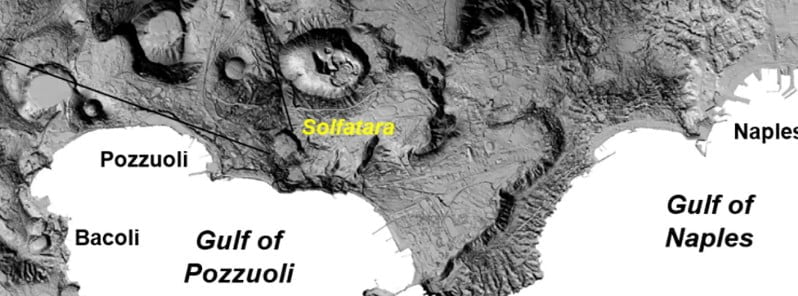Magmatic degassing in Campi Flegrei in recent bradyseismic crises, Italy

A new study published in AGU’s JGR Solid Earth combined the petrological and geochemical data collected in recent decades at Campi Flegrei with numerical simulations, and placed new constraints on the source(s) of the current dynamics of the volcano. The study helps in defining the best monitoring strategies and forecasting a future eruption.
The Campi Flegrei caldera is located in the metropolitan area of Naples, Italy. It’s considered the most dangerous volcano in Europe and is currently in a new phase of unrest that started in 2000 and is still ongoing.
The crisis – whose nature (magmatic or not magmatic) has remained unclear – has persisted intermittently for several decades (main crisis occurred from 1950 to 1952, 1970–1972, and 1982–1984).
“In particular, we show that the measured (N2-He-CO2) geochemical changes at the fumaroles of Solfatara hydrothermal site are the result of massive (about 3 km3 / 0.7 mi3) magma degassing in the deep portion (≥200 MPa, 8 km / 5 miles of depth) of the plumbing system,” authors of the study said.
The degassing mechanism would be able to flood the overlying hydrothermal system with hot gas, thus heating and fracturing the upper crust inducing shallow seismicity and deformation.
This implies that the deep magma transfer process (≥8 km) has been decoupled from the source of deformation and seismicity, localized in the first kilometers (0–4 km / 2.5 miles) of caldera-filling rocks.
This information on magma transfer depth can have important implications for defining the best monitoring strategies and for forecasting a future eruption.
It also highlights how petrological and geochemical data allow us to explore the dynamics of the deep portion of the plumbing system and thus trace the occurrence of recharge episodes, in a portion of the ductile lower crust where magma transfer occurs in the absence of earthquakes.
Reference:
“New Insights Into the Recent Magma Dynamics Under Campi Flegrei Caldera (Italy) From Petrological and Geochemical Evidence” – AGU JGR Solid Earth – February 18, 2022 – https://doi.org/10.1029/2021JB023773 – OPEN ACCESS
Featured image credit: AGU JGR Solid Earth/authors


Commenting rules and guidelines
We value the thoughts and opinions of our readers and welcome healthy discussions on our website. In order to maintain a respectful and positive community, we ask that all commenters follow these rules:
We reserve the right to remove any comments that violate these rules. By commenting on our website, you agree to abide by these guidelines. Thank you for helping to create a positive and welcoming environment for all.